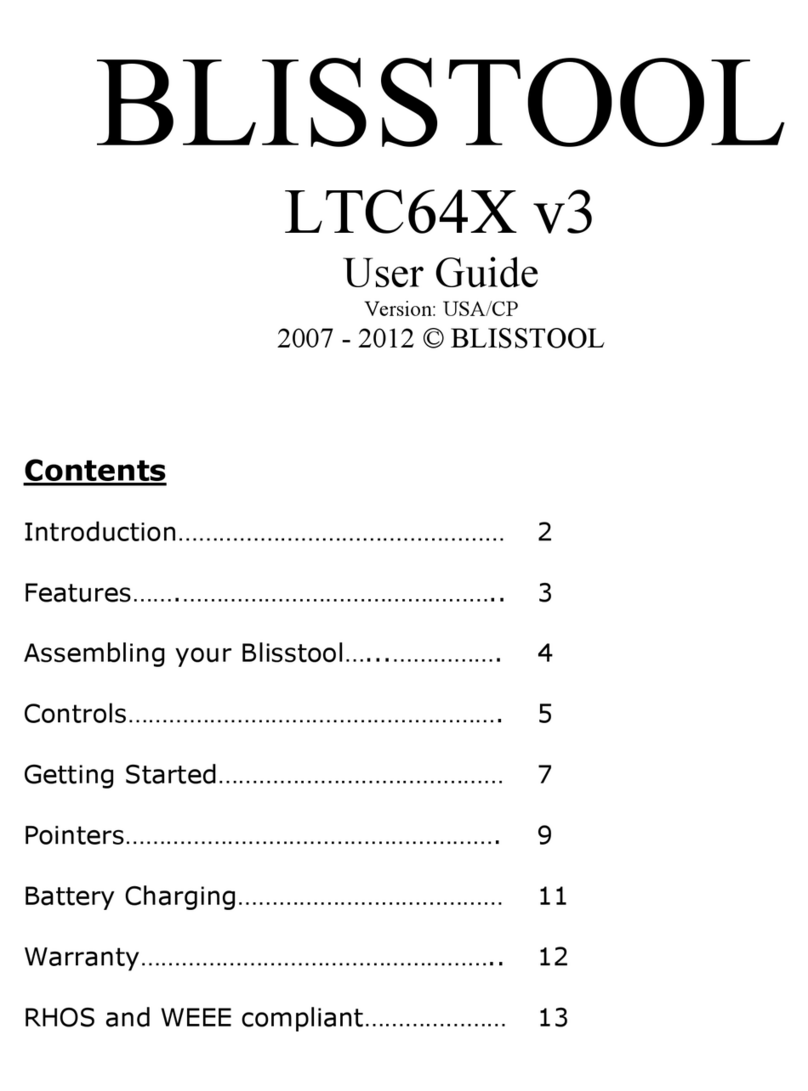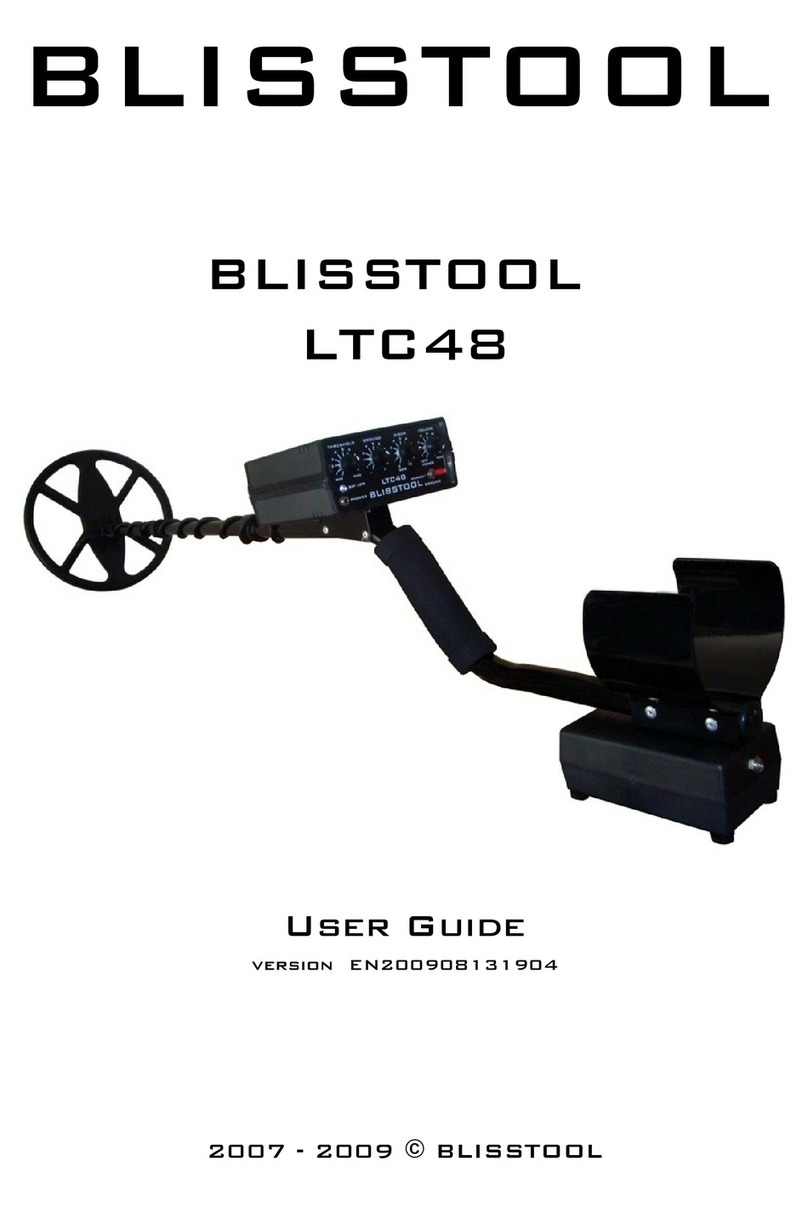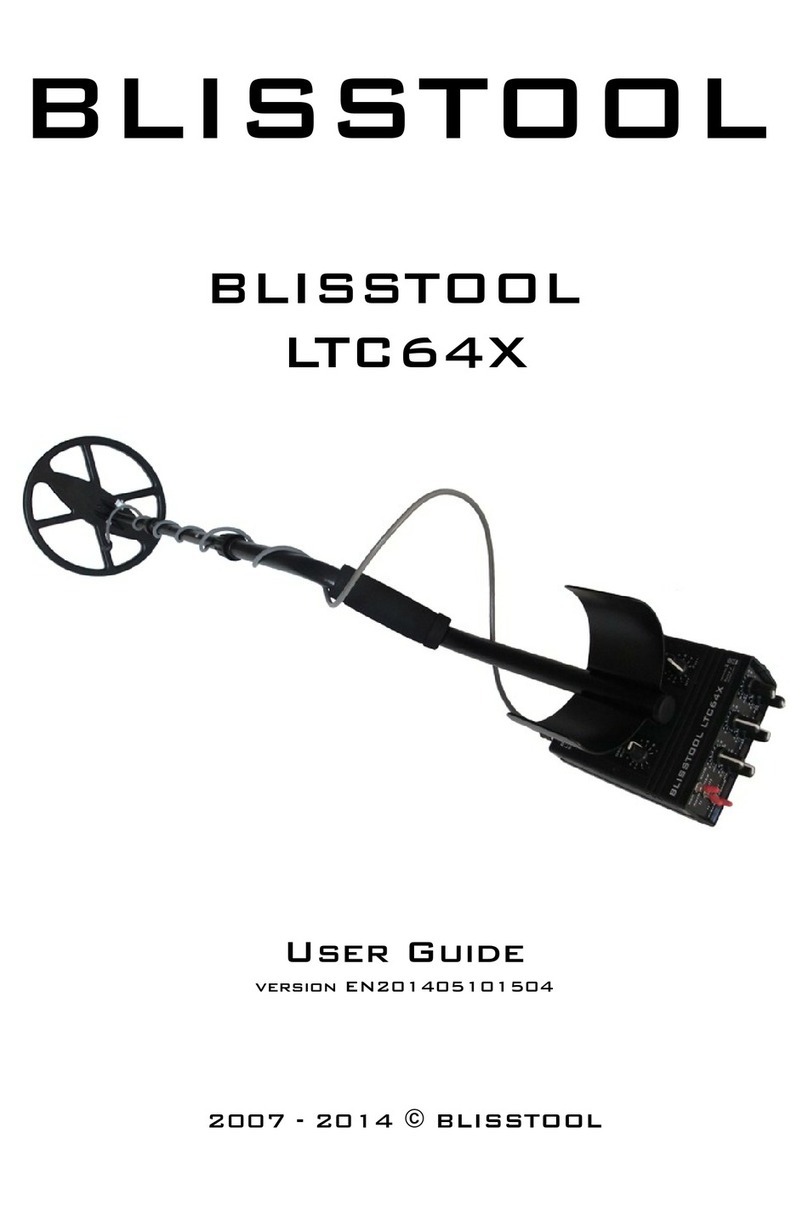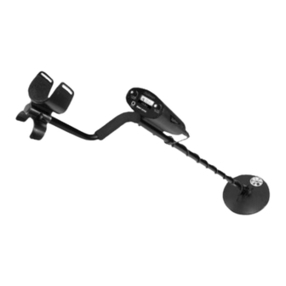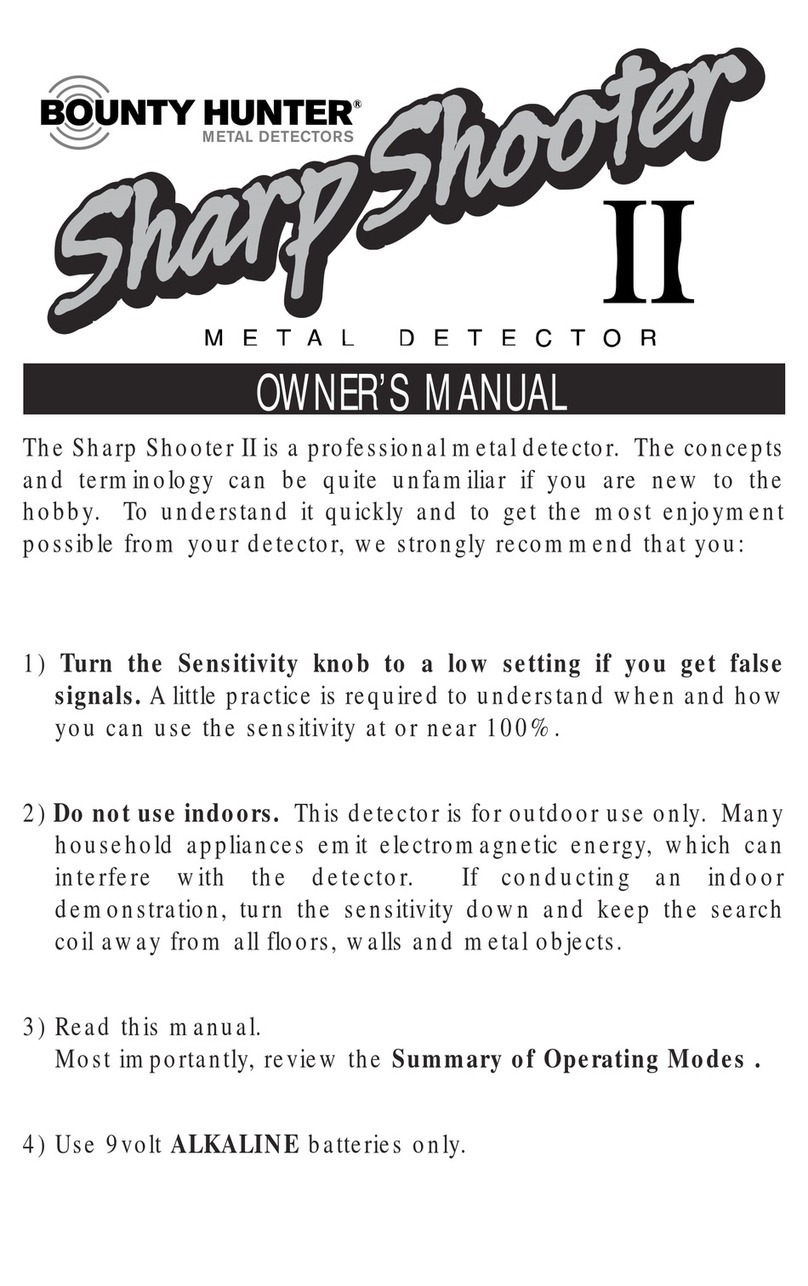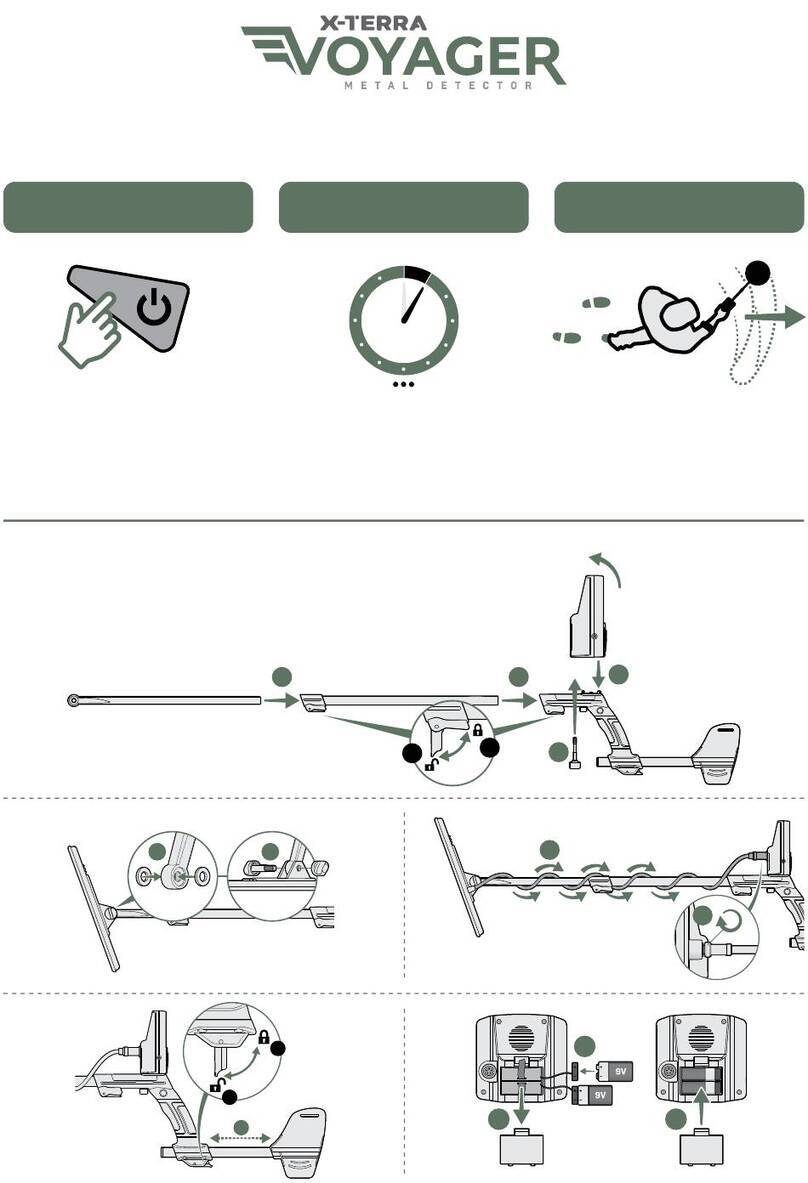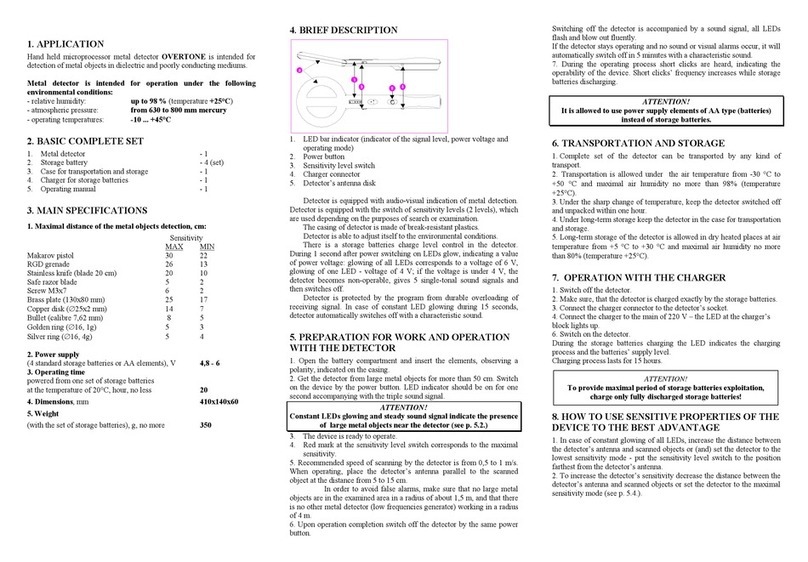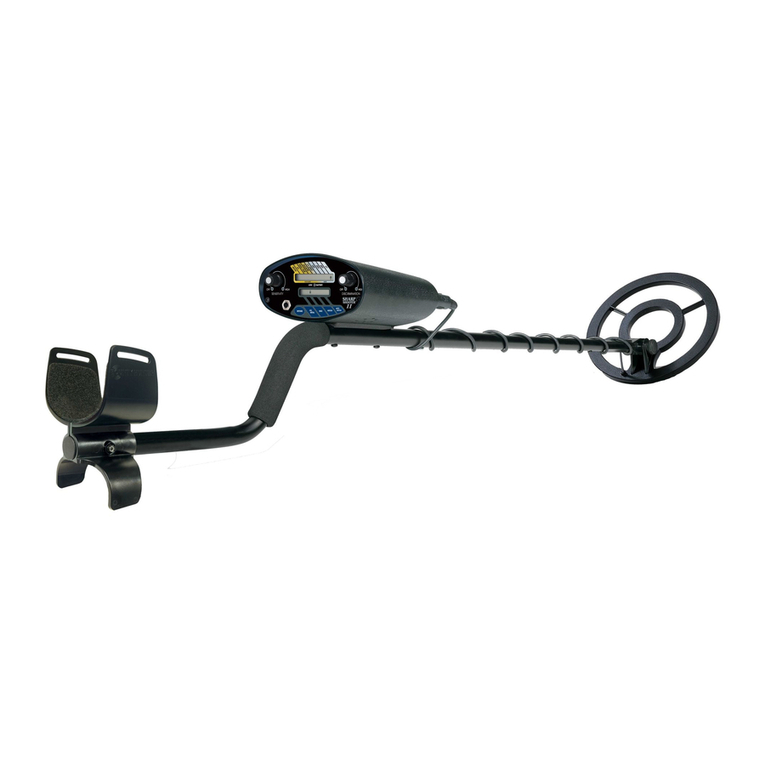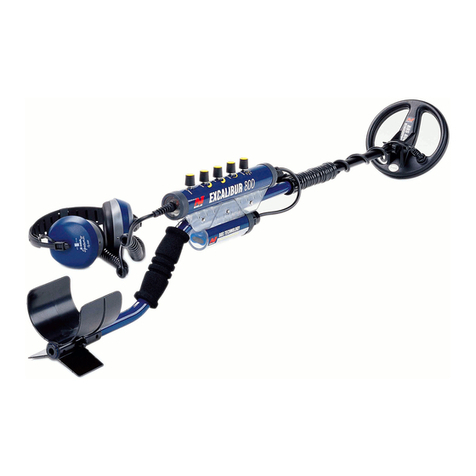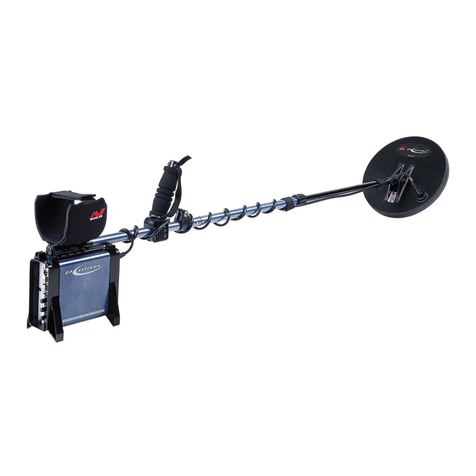Blisstool LTC48X User manual

BLISSTOOL
BLISSTOOL
LTC48X
User Guide
version EN201008241400
2007 - 2010 © BLISSTOOL

Contents
1 Introduction 3
2 Features 4
3 Versions 5
4 Modifications 6
5 Standard package 6
6 Optional accessories 7
6 1 Army backpacks (Kitbag) 7
6 2 External power module BLISSTOOL EBP01B 7
6 3 Stereo headphones 7
7 Device construction 8
8 Device assembling and disassembling 10
9 Control, adjustment and indication appliances 11
9 1 VOLUME potentiometer 11
9 2 GROUND switch 11
9 3 AUTO ZONES switch 11
9 4 GROUND potentiometer 12
9 5 THRESHOLD potentiometer 13
9 6 DISCR LEVEL potentiometer 14
9 7 DISCR WIDTH potentiometer 14
9 8 DISCR DEPTH potentiometer 15
9 9 Loudspeaker 16
9 10 PHONES connector 16
9 11 BAT LOW LED 16
10 Device adjustment and preparation for work 18
11 Search method 18
12 Battery Battery charging 20
13 Practical recommendations 21
14 Indicative and recommended settings 22
14 1 Introduction BSMD code 22
14 2 Settings for maximum depth of detection 23
14 3 Settings for terrains with low degree of mineralization 24
14 4 Settings for terrains with middle degree of mineralization 25
14 5 Settings for terrains with high degree of mineralization 26
15 Warranty support and service 27
16 Legislation 27
17 BLISSTOOL 27
18 Contact information 27
BLISSTOOL LTC48X - User Guide (version EN201008241400) Page 2 of 28

1 Introduction
BLISSTOOL LTC48X is a modern professional metal detector, designed to be used on any type
of terrains, including highly minerali ed terrains, terrains with a high content of ore and highly
contaminated terrains. Has perfect depth and discrimination and is outstanding for its high
quality, easy user’s adjustment and minimal maintenance need. This makes it equally suitable
for beginners and experienced searchers.
Represents extended and improved version of the model BLISSTOOL LTC48, so that entirely
replaces and supplemented it.
It is made of high quality electronics and components such as light and robust detachable
carrier construction made of duraluminum and carbon, light and robust ABS boxes, and 28cm
(11") DD waterproof search coil. They provide its consistent performance regardless of
temperature changes of the environment and durability lined with 3 year worldwide warranty.
Available in two versions: a standard version and version adapted for heavy field conditions.
Each of them is available in three modifications with rechargeable NiMH batteries in complete
with automatic battery charger, and in one modification with alkaline disposable batteries.
There are and two options for configuration of the battery: Solid package or Demountable
package. These choices ensure that cost-beneficial option in accordance with customer
preferences.
Has high detection speed and high recovery speed. This ensures its stability regardless of the
speed of search and allows the efficient detection of deeper objects located near to the iron.
It features manual and automatic ground balance mode, as in automatic mode is available
additional switch with 3 auto ground ones for soils with low, medium and high minerali ation.
These ones make use of the metal detector easily and effectively.
It discrimination contains 3 separate potentiometers (DISCR LEVEL, DISCR WIDTH и DISCR
DEPTH) which allowing controlling of: detection/rejection level of iron, tin-foil and low-grade
non-ferrous metals (usually pollutants); the width (range) of the discrimination area; and: the
depth of discrimination. This provides more opportunities about the setting in contaminated
areas, areas with hot rocks and minerali ed areas, and are a prerequisite for even better
results.
Has adjustable audio threshold, which allowing set its behavior to each particular area and fine
tuning of its sensitivity.
Its audio discrimination, thanks to the perfect human abilities through their hearing to perceive
and analy e in detail the sound signals, is the ideal solution for instant detection, analysis and
recognition even and of the weakest signals by deeply buried objects.
As a concept, BLISSTOOL LTC48X is designed:
- to have excellent depth of detection in all conditions. This is leading to him!;
- to be used on any type of terrains;
- to successfully detect coin placed into ceramics;
- to successfully detect coins in highly minerali ed terrains;
- to have good depth of detection, not only to copper but also to silver and gold objects;
–to have high detection speed and high recovery speed and at the same time to have good
or at least satisfactory stability!
Before using your LTC48X for the first time, we recommend you to read detailed this user guide in
order to optimally use all its capabilities.
BLISSTOOL LTC48X - User Guide (version EN201008241400) Page 3 of 28

2 Features
–Technology: Induction balance (VLF)
–Working frequency: 8.5KH
–Working mode: motion
–Sound discrimination of the metals
–Manual and Automatic ground balance mode
–Switch with 3 auto ground ones
–28cm (11") DD search coil
–Designed to be used on any type of terrains
–Resistance in areas with heavy minerali ed ground
–Adjustable detection/rejection level of iron, tin-foil and low-grade non-ferrous metals
(usually pollutants)
–Adjustable width (range) of the discrimination
–Adjustable depth of discrimination
–High detection speed
–High recovery speed
–Adjustable audio threshold
–Adjustable audio volume control
–3.5mm Stereo headphones outlet<
–3.5mm to 6.35mm external stereo audio adapter for headphones
–Built-in battery (12V/2500mAh NiMH; 12V/1300mAh NiMH; 15V Alkaline)
–Single charge operating time: up to 50 working hours (*45, *25, depending on battery)
–Low battery indicator
–Consumption: min:35mA, max:100mA
–Automatic battery charger (in modifications with NiMH battery)
–Light and robust ABS boxes
–Detachable and adjustable carrier construction made of duraluminum and carbon
–Robust and comfortable handle and armrest
–Electronics shielded against electromagnetic interference
–High quality double shielded against electromagnetic interference cable for the search coil
–Weight in assembled mode (ready for work): 1.9kg
–RoHS compliant
–Developed and manufactured in Bulgaria
–3 Year Worldwide Warranty
BLISSTOOL LTC48X - User Guide (version EN201008241400) Page 4 of 28

3 Versions
BLISSTOOL LTC48X is available in two versions: version 1 (LTC48X v1) и version 2 (LTC48X
v2).
On the front panel of the metal detector both ersions are labeled LTC48X, but on the box with the
electronics, additionally marked is the exact ersion of the metal detector.
LTC48X 1 is the standard ersion, LTC48X 2 is a ersion specially adapted for hea y field
conditions.
LTC48X v1 differs from LTC48X v2 on this that LTC48X v2 is optimized to wo k on:
- highly contaminated terrains;
- highly minerali ed terrains;
- terrains with a high content of ore.
Of the above described terrains, LTC48X v1 also works, but LTC48X v2 is additional optimi ed
for such terrains.
For this purpose, compared with LTC48X v1, LTC48X v2 contain the following
optimizations:
[1] Discrimination optimi ed for highly contaminated with iron, steel and other ancient and
contemporary pollutants terrains:
- improved rejection of small heavily corroded iron and steel, small pieces of wire, heavily
corroded pieces of sheet metal, small iron nails and steel nails, tack, slag and other ancient
and contemporary pollutants;
- increased range of the discrimination level set by potentiometer DISCR LEVEL.
[2] Behavior optimi ed for working on highly minerali ed terrains and terrains with a high
content of ore. The ground and ground-specific background of such terrains, which makes the
detector "noisy", are ignored in a better extent.
The depth of detection is theoretically better in LTC48X v1, but in practice with both versions
are achieved excellent results. It which must be borne in mind, is that in LTC48X v2 because
has increasing range of discrimination by potentiometer DISCR LEVEL, should not be set higher
than the necessary level of discrimination. Otherwise, will be losing some of the maximum
possible depth of detection! In LTC48X v1, in discrimination mode, of most terrains of practice
may safely to work at levels of 6 to 10 of potentiometer DISCR LEVEL. In LTC48X v2, in
discrimination mode, the optimum levels of potentiometer DISCR LEVEL are from level 4 to
about level 6, and potentiometer DISCR WIDTH usually not used (is set at level NORM).
Which version is right for you to judge yourself according to your specific needs.
LTC48X 1 has a maximum depth of detection, but LTC48X 2 works better of highly contaminated
terrains.
All other features are the same for both versions
BLISSTOOL LTC48X - User Guide (version EN201008241400) Page 5 of 28

4 Modifications
Both versions of BLISSTOOL LTC48X are offered with 4 different options for power (capacity
and type of the battery, battery charger):
1/ Rechargeable battery NiMH 12V, 2500mAh (10х1.2V, GP NiMH) and automatic
battery charger 12V, 250mA (Working with a single charge: up to 50 working hours; Long
battery life: approximately 500 cycles of charge-discharge; Battery weight: 330 grams.);
2/ Rechargeable battery NiMH 12V, 2200mAh, Low Self Discha ge (10х1.2V, TY
NiMH LSD) and automatic battery charger 12V, 250mA (Working with a single charge: up
to 45 working hours; Long battery life: approximately 500 cycles of charge-discharge;
Battery weight: 315 grams; Low Self Discharge is a new technology which ensures low
self-discharge of the battery even with prolonged stay.);
3/ Rechargeable battery NiMH 12V, 1300mAh (10х1.2V, GP NiMH) and automatic
battery charger 12V, 130mA (Working with a single charge: up to 25 working hours; Long
battery life: approximately 500 cycles of charge-discharge; Battery weight: 250 grams.);
4/ Alkaline batte y 15V (10х1.5V, GP Ultra Alkaline) for disposable (Working with one
set of elements: up to 50 working hours; Battery weight: 250 grams; Can be upgraded to
NiMH modification, through additional purchases and adding thereto a NiMH battery and
battery charger.).
and with two options for configuration of the battery:
1/ Solid package. It consists 10 spot welded elements 1.2V AA (R6). This option
provides greater durability of the battery and need minimal maintenance. Available only
for versions with NiMH battery;
2/ Demountable package. It consists 10 elements 1.2V AA (R6) put in battery holder
for 10 elements AA (R6). This option allows easy replacement of any defective element or
replacement of low elements with full elements in field conditions. Available for versions
with NiMH battery and for version with Alkaline battery.
All other features are the same for all modifications
The modifications with rechargeable NiMH battery can work and with an alkaline battery, and ice
ersa, the modification with alkaline battery can work with rechargeable NiMH battery.
5 Standard package
1. Metal detector BLISSTOOL LTC48X with 28cm (11") DD search coil BLISSTOOL
DD28SC1 and battery depending on its modification (12V/2500mAh NiMH;
12V/2200mAh NiMH LSD; 12V/1300mAh NiMH; 15V Alkaline)
2. Automatic battery charger BLISSTOOL DP12250 (12V, 250mA) or BLISSTOOL DP12130
(12V, 130mA) (in modifications with NiMH battery)
3. 3.5mm to 6.35mm external stereo audio adapter for headphones
4. User guide
5. Warranty card
6. Invoice
7. Transport and storage box
8. 3 Year Worldwide Warranty
BLISSTOOL LTC48X - User Guide (version EN201008241400) Page 6 of 28

6 Optional accessories
6.1. Army backpacks (Kitbag)
The army backpacks is soft backpack type bag in
which can transport metal detector BLISSTOOL
LTC48X.
The army backpacks carried as a rucksack on your
back.
BLISSTOOL LTC48X be placed in the army
backpacks after disassembling. For this purpose, its
detachable carrier construction is divided into its
three major parts through the unscrewed of the
small and large fixing ring.
Dimensions in unfolded state: rectangle with a
width of 46 centimeters and a height of 68 cm.
6.2. External power module B ISSTOO EBP01B
BLISSTOOL EBP01B is an external power module
whereby the battery of BLISSTOOL LTC48X is
exported outside from the metal detector to reduce
it weight (from 230 to 330 grams depending on
battery).
BLISSTOOL EBP01B has a metal clip type carbine for
attachment to a belt and an adjustable strap to wear
o er the shoulder or waist.
Attaches to the metal detector through stretch and
spiral wound flexible power cable and power jack
which is included in the connector that lies on the
front panel of the power supply module (connector
for inclusion of the automatic battery charger).
The battery can be recharged without remo ing from
BLISSTOOL EBP01B, thanks to the the connector for
inclusion of the automatic battery charger which it has.
6.3. Stereo headphones
- PHILIPS SHP1900
- PLEOMAX PHS-2000
- GEMBIRD MHP-870
- WEILE WL-908MV
BLISSTOOL LTC48X - User Guide (version EN201008241400) Page 7 of 28

7 Device construction
BLISSTOOL LTC48X consists of the following basic elements:
1. Carrier rod
2. Large fixing ring
3. Electronic block with control and indication appliances
4. Handle
5. Armrest
6. Power supply module
7. Intermediate connecting rod
8. Small fixing ring
9. Lower connecting rod
10. Plastic bolt and nut
11. Search coil
Fig.1 / Const uction of metal detecto BLISSTOOL LTC48X
For easy assembling and
disassembling of the device, in the
standard package:
–the carrier rod with the large
fixing ring, the electronic block,
the handle, the armrest and the
power supply module are
combined in a single component;
–the small fixing ring is mounted on
the intermediate connecting rod;
–the lower connecting rod and the
search coil are assembled together
with the plastic bolt and nut.
Fig. 2 / Components of metal detecto BLISSTOOL LTC48X
BLISSTOOL LTC48X - User Guide (version EN201008241400) Page 8 of 28

The carrier rod is made from duraluminum pipe. The large fixing ring that is mounted on its
lower end is used for connecting the pipe with the intermediate connecting rod.
The electronic block consists of a plastic box in which is mounted the metal detector’s
electronics. The control and indication appliances lie on the front panel, the back panel and the
bottom of the box.
The handle is part of the carrier rod and is coated with soft and solid foam.
For better stability, the armrest is made from duraluminum.
The power supply module consists of a plastic box in which is mounted the battery. On the
front panel of the box is mounted connector for plugging of the battery to the battery charger
(is available in the standard package with NiMH modifications), so that the charging of the
battery could be carried out when needed
The intermediate connecting rod is made from duraluminum pipe. At its upper end it is
connected by the large fixing ring to the carrier rod – it fits into it, while at its lower end it is
connected to the lower connecting rod by the small fixing ring.
The lower connecting rod is made from carbon, so that it does not interfere with the normal
working mode of the metal detector. At its upper end it is connected by the small fixing ring to
the intermediate connecting rod – it fits into it, while at its lower part ends with a plastic
no le by which is connected to the search coil.
To not affect the intermediate connecting rod on the work of the metal detector because it is
made from duraluminum, ie metal, it is recommended that the lower connecting rod to be
inserted in the intermediate connecting rod to a situation in which remain at least 20-30
centimeters away from the top of the search coil to the small fixing ring.
To quickly and easily set the desired total length of the carrier construction, the intermediate
connecting rod has openings at different le els, one of which, according to the user are inserts the
fixed mechanism type bud, a ailable on the lower connecting rod.
The search coil is connected to the plastic no le of lower connecting rod via the plastic bolt
and nut. Between the ears of the search coil and the plastic no le of the lower connecting rod
put emollient and fixed rubber type washer, which prevent ears of the search coil from
deformation and breakage when tightening. Thus, the search coil can be installed and removed
repeatedly from the lower connecting rod.
The search coil via the socket of the connecting shielded cable, is connecting to the connector
mounted on the rear panel of the electronic block.
If necessary to change the position of the search coil to the lower connecting rod (change the
working angle during working with the metal detector or folding to carry and transport) is
necessary to loose coupling fixing by a plastic bolt and nut and after the new setting, it can be
tight to be fix the search coil in the new position.
Changing the working angle in tight situation can lead to breakage of the ears of the search coil,
deformation of the ears and the search coil or a fatal frustration of the search coil and changes its
parameters.
When changing the working angle of the search coil to the lower connecting rod must be
monitored for the presence of an advance of the bottom of the connecting shielded cable of the
search coil to keep it stretched too much as this can cause damage its.
Recommended always to pro ide a small ad ance of the connecting shielded cable of the search coil
in its lower part, just abo e the nozzle during which it comes out of the search coil.
For fixing the bottom of the connecting shielded cable of the search coil, is used included in the
package fixing patches type velcro.
BLISSTOOL LTC48X - User Guide (version EN201008241400) Page 9 of 28

8 Device assembling and disassembling
The metal detecto BLISSTOOL LTC48X is assembled in the following sequence:
1. The upper part of the lower connecting rod is attached to the lower part of
intermediate connecting rod via the small fixing ring, and adjusted at the appropriate
length.
It is recommended that the mounting of the lower connecting rod to the intermediate
connecting rod should be carried out, following the sequence below:
–the small fixing ring has to be unscrewed loose from the intermediate connecting rod
and put on the lower connecting rod;
–the lower connecting rod is inserted in the intermediate connecting rod at the
appropriate length;
–the small fixing ring is tightened until it is fixed.
2. The upper part of the intermediate connecting rod is attached to the carrier rod via the
large fixing ring, and adjusted at the appropriate height.
It is recommended that the mounting of the intermediate connecting rod to the carrier
rod should be carried out, following the sequence below:
–the large fixing ring has to be unscrewed loose from the carrier rod and put on the
intermediate connecting rod;
–the intermediate connecting rod is inserted in the carrier rod at the appropriate
length;
–the large fixing ring is tightened until it is fixed.
3. The search coil has to be adjusted hori ontally against the ground surface, while the
user is in an upright (working) position and is holding the metal detector by the handle.
This adjustment is possible, if the plastic bolt and nut used for assembling the search coil
with the lower connecting rod are not tightly fastened.
4. The connecting shielded cable of the search coil is winded uniformly up the lower and
intermediate connecting rods and the end jack of the cable is plugged in and tightened on
the connector that lies on the back panel of the electronic block.
The cable, at its lower end near the search coil, has to be slightly loose, so that it is not
damaged when the search coil has been bent against the lower connecting rod, for
example when the device is folded for carrying and transporting.
Additional, the cable can be fixed through patches type velcro included in the standard
package.
The coil cable ends with a jack and there is a single correct position for it so that it could
be plugged in the coil connector, which lies on the back panel of the electronic block. In
this position, the hollow cursor of the jack falls in with flange cursor of the connector, and
when inserted, the jack enters the connector into a depth of around 10 mm. After the
jack is plugged in, it is screwed to the connector by the means of the available metal
stopping nut, used as a shield.
The incorrect insertion and/or the application of a brute force while incorrectly inserting the
jack could lead to damaging the metal detector.
The plugging in and out of the jack is done while the metal detector is switched off
(VOLUME potentiometer is turned in "OFF" position (Fig.3)).
The disassembling of the device is ca ied in a eve sed o de .
BLISSTOOL LTC48X - User Guide (version EN201008241400) Page 10 of 28

9 Control, adjustment and indication appliances
The control, adjustment and indication appliances lie on the front panel, back panel and
bottom of the electronic block (Fig.3).
Desc iption of the va ious appliances:
9.1. VO UME potentiometer
The VOLUME potentiometer ser es as the on/off the metal detector (le el
"OFF POWER") and to regulate the audio olume (le els from "1" to "MAX").
The chosen position from the potentiometer scale (usually between levels
"3" and "6") should correspond to pleasant sounds made by the metal
detector, ie that are neither loud, nor quiet.
9.2. GROUND switch
The GROUND switch ser es for switching between the two working modes of
the metal detector:
MANUAL: Manual ground balance
AUTO: Automatic ground balance
Those two working modes relate to the chosen technology for eliminating the ground (terrain)
interference on the metal detector’s work. This interference usually causes instability of the
device and false signal registration (during the course of the search while the search coil is
moving, the device is making sounds without necessarily detecting a real metal object).
When in a manual ground balance working mode (GROUND switch turned to the "MANUAL"
position), the ground interference is eliminated by manual adjustment of the metal detector by
the user, by following the procedure given in the description of the GROUND potentiometer
below. This working mode is appropriate for terrains with homogeneous soil, where the metal
detector would reach its full potential by a fine manual adjustment.
When in an automatic ground balance working mode (GROUND switch turned to the "AUTO"
position), the metal detector’s electronics automatically eliminates the ground interference and
there is no further need for manual balance adjusting by the GROUND potentiometer from the
user and no further relation with the chosen GROUND potentiometer level. This working mode
is appropriate for terrains with a heterogeneous soil. In order to optimi e and achieve the best
possible balance, the automatic ground balance working mode is divided into 3 ground ones
with a small area of correlation. They are selected by a switch AUTO ZONES as described
below.
9.3. AUTO ZONES switch
The AUTO ZONES switch ser es to set one of three a ailable automatic
ground zones of work in automatic ground balance working mode.
The individual ones are numbered as ones "1", "2" and "3". This
numbering corresponds to: soils with black and/or negative minerali ation
(„1“); not minerali ed or weakly minerali ed soils („2“); soils with a color
and/or positive minerali ation („3“).
BLISSTOOL LTC48X - User Guide (version EN201008241400) Page 11 of 28

To dete mine which of the th ee zones eliminates the best influence of soil is
necessa y:
- choose the auto ground balance working mode (GROUND switch turned to "AUTO" position);
- turn the DISCR LEVEL potentiometer to "GBS" position (Ground Balance Setting);
- turn THRESHOLD potentiometer to a level, just before the level where the metal detector
starts slightly oom sound made (issued torn sound, bu ing, whi ) or one or two levels before
the level of oom (recommended for beginners searchers).
Then is done vertical (up-down) movement of the search coil ranging from 2-3 cm to 20-25 cm
above the terrain and simultaneously switch AUTO ZONES switches alternately between the
three available positions ( ones).
Most appropriate for use is the zone where the descriptions in the way of mo ement of the metal
detector search coil does not beeps or issue possible weak sound, or at least to pre-set audio
threshold le el did not change significantly.
In minerali ed terrains, if has a strong responsive signal from the terrain and selection of most
appropriate auto ground one is difficult or the seeker has small practical experience, is
recommended THRESHOLD potentiometer to return with one or two levels back at the level
where the metal detector starts to slightly oom, then proceeding to the descriptions above
balancing. In addition, in order to reduce the response signal from the ground, can be set in
advance desired level of discrimination (DISCR LEVEL potentiometer from level "GBS" is placed
in the desired operating level) and then performed described above choice of one.
Described abo e, ertical mo ement of the search coil, to the choice of most appropriate auto
ground zone, should be carried at an area with no metal objects near the search coil, ie the piece of
land on which it is described ertical mo ement of the search coil should not contain metal objects.
Otherwise they would interfere the selection process one therefore can not be selected most
appropriate auto ground one. Whether the area is clean is easily established, when the search
coil is moved hori ontally above the terrain, ie without changing its distance towards the
ground. When there are no metal objects, the predefined from the THRESHOLD potentiometer
sound would not be changed.
After the choosing of auto ground one has been finished, the GROUND switch remains in
"AUTO" position (auto ground balance), while the DISCR LEVEL and THRESHOLD
potentiometers are turned to the desired levels.
When changing the terrain with another, significantly different from the pre ious (changing the soil
characteristics), to the de ice remain stable, necessary as described abo e, again to assess what is
most appropriate in cases where auto ground zone.
9.4. GROUND potentiometer
The GROUND potentiometer ser es for suppressing the ground interference
while in a manual ground balance working mode.
Fo manual adjustment of the g ound balance is needed:
- to be chosen the manual ground balance working mode (GROUND
switch turned to "MANUAL" position);
- the DISCR LEVEL potentiometer to be turned at "GBS" position (Ground
Balance Setting);
- the THRESHOLD potentiometer to be turned at a level, just before the
level where the metal detector starts slightly oom sound made (issued
torn sound, bu ing, whi ) or one or two levels before the level of oom
(recommended for beginners searchers).
Then is done vertical (up-down) movement of the search coil ranging from 2-3 cm to 20-25 cm
above the terrain, simultaneously with turning the GROUND potentiometer. At some levels of
the GROUND potentiometer scale, the sound is louder when the search coil is near the ground,
while at others the sound is louder when the search coil is high above the ground.
BLISSTOOL LTC48X - User Guide (version EN201008241400) Page 12 of 28

The balancing is actually finding the le el (position) from the GROUND potentiometer, in which the
descriptions in the way of mo ement of the metal detector search coil does not beeps or issue
possible weak sound, or at least to preset audio threshold le el did not change significantly.
In minerali ed terrains, if has a strong responsive signal from the terrain and the manual
balancing is difficult or the seeker has small practical experience, is recommended THRESHOLD
potentiometer to return with one or two levels back at the level where the metal detector
starts to slightly oom, then proceeding to the descriptions above balancing. In addition, in
order to reduce the response signal from the ground, can be set in advance desired level of
discrimination (DISCR LEVEL potentiometer from level "GBS" is placed in the desired operating
level) and then carry the balancing process of the device according to the above description.
The balancing should be carried at an area with no metal objects near the search coil, ie the piece of
land on which it is described ertical mo ement of the search coil should not contain metal objects.
Otherwise they would interfere the balancing process and the metal detector can not be
balanced or will be balanced incorrectly. Whether the area is clean is easily established, if the
GROUND potentiometer is turned to a middle position and the search coil is moved hori ontally
above the terrain, ie without changing its distance towards the ground. When there are no
metal objects, the predefined from the THRESHOLD potentiometer sound would not be
changed. One other possibility is the chosen balancing area to be searched for metal objects in
advance while using the automatic ground balance working mode (GROUND switch turned to
"AUTO" position).
After the balancing has been finished, the GROUND switch remains in "MANUAL" position
(manual ground balance), while the DISCR LEVEL and THRESHOLD potentiometers are turned
to the desired levels.
When changing the terrain with another, significantly different from the pre ious (changing the soil
characteristics) the de ice should be balanced again following the abo e-described way, so that it
remains stable.
9.5. THRESHO D potentiometer
The THRESHOLD potentiometer ser es for assigning the necessary audio
threshold and sensiti ity of the metal detector.
It is adjusted with no metal objects around the metal detector’s search
coil and depends on the terrain.
The best depth for finding metal objects is achie ed, when the THRESHOLD
potentiometer is turned in a position, corresponding to a quiet zoom sound
made by the metal detector in working mode (issued torn sound, buzzing,
whiz).
Quiet oom sound mode is suitable for experienced seekers. The beginners should work at
lower levels.
When working in manual ground balance mode, is necessary the final audio threshold level to
be set only after the unit is balanced.
The maximal audio threshold corresponding to a stable device condition depends on the
terrain’s characteristics, the device balancing (in the manual ground balance working mode)
and the user search speed.
BLISSTOOL LTC48X - User Guide (version EN201008241400) Page 13 of 28

9.6. DISCR EVE potentiometer
The DISCR LEVEL ser es for adjusting the detection/rejection le el of iron,
tin-foil and low-grade non-ferrous metals (usually pollutants), and for baseline
exclusion of the discrimination (All metals mode) when it is set to le el "0".
In level "0" the disc imination is excluded, ie the metal detector
makes unaltered sound for all metals, ie it does not distinguish them.
That is why this position is the same as the "GBS" position, in which it is
recommended to carry out precision choice of auto ground one and/or
manual balancing of the device, with the aim of achieving the maximal
balance for a particular terrain.
For a complete exclusion of discrimination may also further described below DISCR WIDTH and
DISCR DEPTH potentiometers to be placed at its minimum level (DISCR WIDTH at a level
"NORM", DISCR DEPTH at level "0").
When inc easing the level of the DISCR LEVEL potentiomete , the metal detecto
sta ts to distinguish the metals (Disc imination mode), and each successive level betters
the discrimination, ie the metal detector rejected to a greater extent iron, tin-foil and low-
grade non-ferrous metals
When detecting non-ferrous metals (copper, bronze, sil er, gold) it makes deep-toned, non-pausing
sound, while for the ferrous metals (iron) the sound is pausing (recurring).
For levels from "4" to "10", the metal detector rejects at a different level iron objects, tin-foil
and low-grade non-ferrous metals, ie when detecting them it is making either no sound or a
quiet pop sound.
For practical use when searching for non-ferrous metals are recommended operating with the
following le els of DISCR LEVEL:
- For LTC48X 2: from „4“ to „6“.
- For LTC48X 1: from „6“ to „10“.
When detecting vibratory (dubious) signal, usually for heavily corroded iron, iron with alloys or
deeply buried object, the level could be increase more in order to get more accurate signal
discrimination. The surface sweeping of the particular terrain could contribute to the further
improvement of the detecting, because it results in shortening the distance to the buried
detected object.
DISCR LEVEL potentiometer is the main potentiometer for the discrimination. In order to
convenience, it is available on the front panel of the electronic block. Described below DISCR
WIDTH and DISCR DEPTH potentiometers (available at the bottom of the electronic block) are
complementary and can be set to a single specified levels in accordance with instructions for
their use.
9.7. DISCR WIDTH potentiometer
The DISCR WIDTH potentiometer ser es for adjusting of the width (range) of
the discrimination area:
- iron and tin-foil (le el NORM = LTC48 discrimination);
- iron, tin-foil and low-grade non-ferrous metals (le els from "1" to "9" and
le el "WIDE").
The set level of this potentiometer, sets the maximum width of the area
of discrimination for DISCR LEVEL potentiometer.
In the level "NORM", the discrimination has the same width as the base version (LTC48). All
other levels (from "1" to "9" and level "WIDE") provide a wide area, ie greater discrimination.
It is recommended that work on possible small le els of DISCR WIDTH potentiometer.
BLISSTOOL LTC48X - User Guide (version EN201008241400) Page 14 of 28

In light and clean terrains is advisable to work at level "NORM". In polluted terrains, terrains
with hot rocks and minerali ed terrains is desirable to operate at levels between:
- For LTC48X v2: from „NORM“ to „4“.
- For LTC48X v1: from „NORM“ to „6“.
Higher levels should be set only in extreme necessity.
Set higher of real necessary le el of DISCR WIDTH potentiometer (the width discrimination), in
combination with a set of higher le el of DISCR LEVEL potentiometer (degree of discrimination) may
result in the rejection of weak color signals of small or deep buried ferrous metals.
In LTC48X v2 because has increasing range of discrimination by DISCR LEVEL potentiometer,
DISCR WIDTH potentiometer usually not used (set to level NORM).
9.8. DISCR DEPTH potentiometer
The DISCR DEPTH potentiometer ser es for adjusting the depth of
discrimination (the maximum depth to which the metal detector distinguish
the metals).
In position "0" depth of discrimination is practically equal to 0 cm, ie the
metal detector issue the same sound (single solid signal) for all metals
and consequently do not distinguish and reject them.
With increasing the level, depth of discrimination begins to grow, and increasing from the
minimum 0 cm to a peak of about 30-40 cm, while each successive level the depth of
discrimination is greater, ie at a level "10", the depth of discrimination is most appropriate and
at this level the metal detector distinguish the metal at greater depth. As a result, on detection
of non-ferrous metals (copper, bron e, silver, gold) can hear a deep-toned, continuous non-
pausing sound, but for ferrous metals (iron) the sound is pausing (recurring). The specific
behavior depends on the current levels of DISCR LEVEL and DISCR WIDTH potentiometers.
Should not be working with more than the required depth of discrimination set by DISCR DEPTH
potentiometer. Otherwise, will be losing some of the greatest possible depth of detection!
For practical use, in light and clean terrains, when searching for non-ferrous metals, are
recommended operating at levels from "5" to "7". In polluted terrains, terrains with hot rocks
and minerali ed terrains are recommended work at levels between "9" and "10". These levels
may be used in cases where targets the maximum depth of discrimination.
In the terrains strewn with pottery, it is desirable to work with smaller le els of DISCR DEPTH
potentiometer to more effecti e detection of non-ferrous metal located to the indi idual ceramics
pieces.
In this case, the metal detector is desirable to be advance balanced and tuned to the specific
ceramics, as described in 9.3 and 9.4 ways (manual and auto ground balance).
In the discrimination mode, intentional interception through the same signal at different levels
of DISCR DEPTH potentiometer can be made estimations about the type of the detected metal
(ferrous or non-ferrous), the depth of the detected metal (mainly for ferrous metals), the
quality of detected metal (low or high) and si e of the detected metal (small or large), or at
least to gain additional data for the detected signal in order to judge it worth to be excavated
(uncovered):
- If the detected signal is from high quality and/or large non-ferrous metal and/or shallow
buried non-ferrous metal, then with increasing the levels of DISCR DEPTH potentiometer from
level "0" to about level "6", the sound produced by the device will not change or will be
changed slightly;
- If the detected signal is from low quality and/or small non-ferrous metal and/or deeply buried
ferrous metal, then with increasing the levels of DISCR DEPTH potentiometer from level "0" to
about level "7", the sound produced by the device will significantly change as will be blunt and/
or will occur the first signs of rejection;
BLISSTOOL LTC48X - User Guide (version EN201008241400) Page 15 of 28

- If the detected signal is from ferrous metal (iron), then with increasing the levels of DISCR
DEPTH potentiometer from level "0" to about level "10", at high levels will lead to the
emergence of the typical for ferrous metals double pulled sound and/or to the level of total
rejection, or at least pop of the signal. Actual level at which rejection begins (the pop) is in
direct proportion dependence on the depth of which is buried the ferrous metal.
Actual behavior of the device in the above described situations are largely determined by the
given current levels of DISCR LEVEL and DISCR WIDTH potentiometers.
9.9. oudspeaker
The Loudspeaker ser es for producing a sound when an object is detected. The sound is deep-toned
and non-pausing for non-ferrous metals and recurring (repeating) for ferrous metals (iron).
The loudspeake lies on the back panel of the elect onic block.
9.10. PHONES connector
The PHONES connector ser es for plug to metal detector, if necessary, stereo
headphones with 3.5mm stereo jack. When the headphones are plugged in,
the loudspeaker is switched off automatically and the metal detector’s sound
could be heard only in the headphones.
To the PHONES connector, may also include a 6.35mm stereo headphone jack means available
in the standard package a 3.5mm to 6.35mm external stereo audio adapter for headphones.
To protect your hearing, it is desirable before turning stereo headphones to BLISSTOOL
LTC48X, to reduce the volume of the metal detector by VOLUME potentiometer, as put it
between levels "2" and "3".
The use of stereo headphones with high-set olume of the VOLUME potentiometer can seriously
damage your hearing!
The use of stereo headphones while using the metal detector has many advantages:
- stereo headphones block outside noise such as wind and traffic and allow you to hear better,
even the weakest signals from deeply buried metal objects;
- through their use, the sound of your metal detector will not interfere with other searchers
around you;
- their use, provides reduced power consumption from the battery of the metal detector,
leading to an extension of its life.
9.11. BAT OW ED
The BAT LOW LED shows the a ailable charge in the battery. When this LED
lights up, it is a signal that the battery is exhausted. In ery low battery, from
the loudspeaker of the metal detector began to hear periodic pulled sounds
and the metal detector stops working or not working correctly.
The charging of the battery (for modifications with NiMH battery) or replacement with a new
battery (for modification with alkaline battery) should be carried according to the description in
12.
BLISSTOOL LTC48X - User Guide (version EN201008241400) Page 16 of 28

Fig. 3 / Cont ol, adjustment and indication appliances of BLISSTOOL LTC48X
BLISSTOOL LTC48X - User Guide (version EN201008241400) Page 17 of 28

10 Device adjustment and preparation for work
The metal detector is ready for use when the battery is charged and intact (the BAT LOW LED is not
lit up).
Before initial use, to the modifications with NiMH battery, please charge the battery at least 8
hours (from 8 to 16 hours) through the automatic battery charger available in the standard
package, as described in 12. The NiMH battery reaches full capacity and respectively
toughness, after at least about 5 cycles of charge-discharge.
After the metal detector is assembled according to the description in 8, it can be turned on via
turning the VOLUME potentiometer from left (level "OFF POWER") to right. This potentiometer
also serves for adjusting the desired audio volume (levels from "1" to "MAX").
The choice of manual or automatic mode to eliminate the influence of land is done by GROUND
switch described in 9.2, and the optimal way of tuning and balance, according to the selected
mode are made according to the description available in 9.3 and 9.4.
The setting of the desired degree of discrimination (distinction of the metals) is performed by
DISCR LEVEL potentiometer as description in 9.6. The width of the discrimination is set by
DISCR WIDTH potentiometer as description in 9.7, and the depth of discrimination is set by
DISCR DEPTH potentiometer as description in 9.8.
If the target is detection of any type of metals is necessary DISCR LEVEL potentiometer to be
set at level "0". For a complete exclusion of the discrimination, DISCR WIDTH potentiometer
and DISCR DEPTH potentiometer should be placed at its minimum level (DISCR WIDTH at a
level "NORM", DISCR DEPTH at level "0").
In the case of ignoring the whole black metal (detection of non-ferrous metals only), ie this is
a discrimination mode, it is necessary DISCR LEVEL, DISCR WIDTH and DISCR DEPTH to be
set at the following recommended levels:
1. DISCR LEVEL potentiometer:
- Fo LTC48X v2: from „4“ to „6“.
- Fo LTC48X v1: from „6“ to „10“.
2. DISCR WIDTH potentiometer:
- Fo LTC48X v2: „NORM“.
- Fo LTC48X v1: „NORM“.
3. DISCR DEPTH potentiometer:
- Fo LTC48X v2: from „6“ to „10“.
- Fo LTC48X v1: from „6“ to „10“.
And lastly, with the THRESHOLD potentiometer are adjusts the audio threshold to the desired
level.
With this, the metal detector is adjusted and ready for work.
11 Search method
Metal detector BLISSTOOL LTC48X works in motion mode, ie it reacts to a metal object buried in
the ground only when the search coil is swung abo e it.
The searching for metal objects is actually by mo ing the search coil abo e the ground surface.
While doing this, the search coil has to be held parallel towards the ground surface and at a
minimum distance above it. The raising reduces the search depth.
BLISSTOOL LTC48X - User Guide (version EN201008241400) Page 18 of 28

The search consists of a uniform and
slow swinging of the coil one side to
another, while the user holds the
metal detector’s handle and uses the
armrest for support.
Too fast or too slow moving of the coil
could result in shortening the search
depth, especially for deeply buried or
small objects.
The search coil path during the search
resembles a ig ag movement, which
is a result from the uniform and slow
swinging of the coil one side to
another while the user is moving
forward.
The swing’s breadth and the user’s
speed are chosen according to the
terrain, the sloping and the si e of the
terrain to be searched.
During swinging the user should a oid
hitting the search coil in the a ailable
objects on the terrain (stones, roots and
parts from tree and shrubs, une en
ground).
The precise location of the detected object (centering of the signal) is determined by mo ing the
search coil in two perpendicular axes, while the user stands still or turns round for detecting the
signal from different sides.
To gain an idea for the depth of which is the detected object, the search coil gradually lifted in
the air above the ground and monitor height to which the metal detector still detect the
object. This, together with specific particular sound (power, duration, purity) is sufficient in
most cases to determine whether it is a shallow or deep object, respectively large or small
object. For this purpose, helps the already described above centering of the signal to study
the area of detection: whether it is narrow or wide.
BLISSTOOL LTC48X - User Guide (version EN201008241400) Page 19 of 28

12 Battery Battery charging
BLISSTOOL LTC48X is available in several modifications according to type, capacity and
configuration of the battery. Please before you continue with this point read detailed the
information available in 4.
The battery is located in the power supply module and is connected to a metal detector
electronics via a standard 6F22 battery connector, which creates an opportunity, if necessary,
easily be on, off, replaced. In order to better safety and prevent injuries, BLISSTOOL LTC48X
has the protection from high voltage and erroneous inclusion of the battery (confusion of the
poles).
To access the battery is required by screwdri er or other suitable tool to be unco ered four screws
a ailable on the lid of the power supply module.
The NiMH batteries has around 500 charging/discharging cycles (battery life), after which its
capacitance drops sharply and must be replaced with a new battery. When the NiMH battery is
exhaust, it can be recharged via a battery charger.
The alkaline batteries are disposable and after being exhausted must be replaced with new
ones.
If your BLISSTOOL LTC48X is modification with alkaline batteries, if no longer using it, remo e the
alkaline batteries from the metal detector.
The following instructions about the recharging refer to modifications with NiMH battery. These
modifications are standard equipped with an automatic battery charger.
Do not attempt to recharge alkaline batteries. They are disposable and the attempt to recharge them
can cause explosion, fire or damage of the battery charger and the metal detector.
The battery charging has to be done only by the automatic battery charger that is included in
the standard package. It is designed to ensure the quality and safety during the battery
charging process.
To charge the battery, plug in the battery charger jack into the connector that lies on the front
panel of the power supply module. Then the battery charger contact-plug is plugged into the
~220V circuit.
The charging continues from 3 to 16 hours, depending on the battery level of discharge. It is
not required to keep a close watch on the charging process, as the battery charger is
automatic and after the battery charging is finished it switches to a stand-by mode, which
protects the battery from over-charging.
The green LED lits up when the battery charger is plugged in ~220V circuit, which indicates that the
charger is working properly.
The charging process and the charging stages are indicated with the different light intensity of the
red LED – when the battery is discharged, it is either out or is dimly lit up, while during the charging
process the intensity is increased, resulting in a bright intensity when fully charged.
After the charging process has been finished, the battery charger should be switched off
following the reversed order: plugging off the ~220V circuit by pulling out the power supply
contact-plug from the wall-plug, then the battery charger jack is plugged off.
During charging, the metal detector should be switched off. Switching on the detector while being
charged could cause serious damage to the electronic block or to decrease its quality.
The built-in rechargeable NiMH battery does not need any further maintenance besides being
charged.
BLISSTOOL LTC48X - User Guide (version EN201008241400) Page 20 of 28
Table of contents
Other Blisstool Metal Detector manuals
Popular Metal Detector manuals by other brands
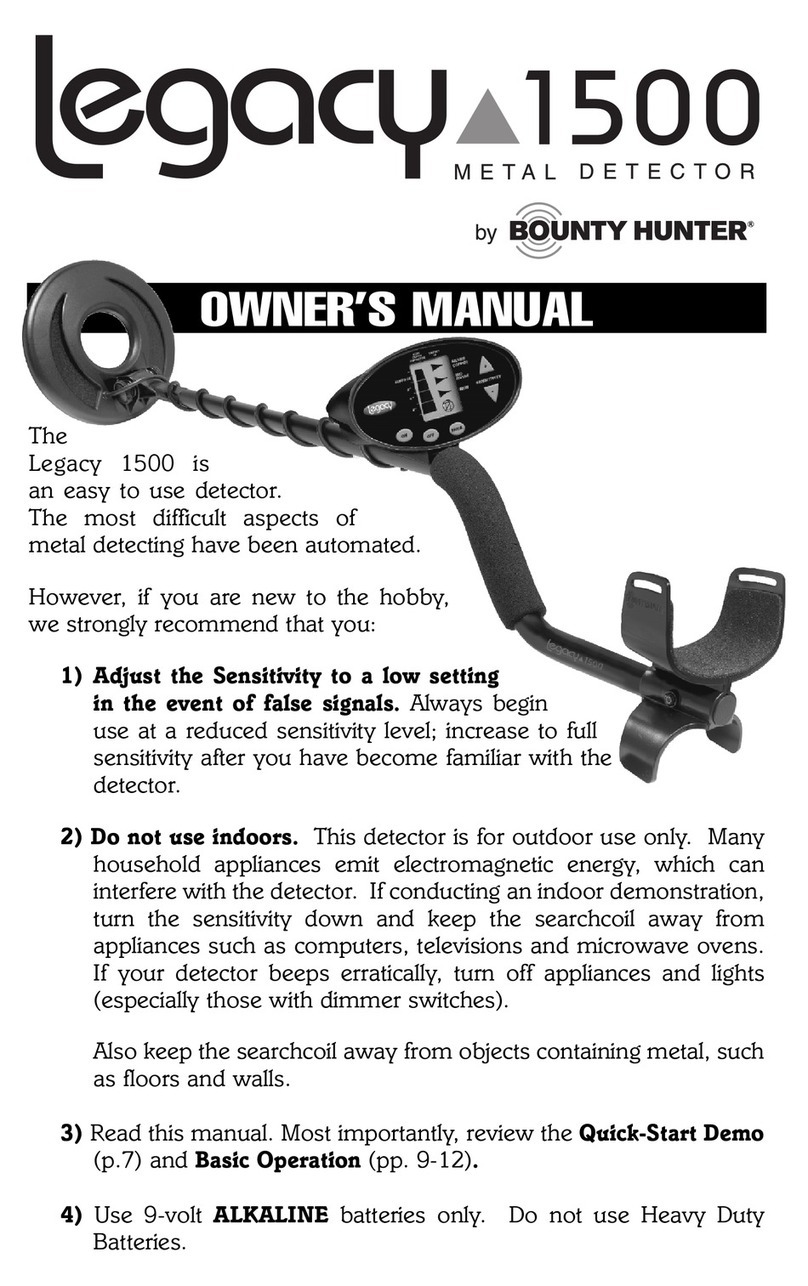
Bounty Hunter
Bounty Hunter Legacy 1500 owner's manual

WGI Innovations
WGI Innovations GROUND EFX STORM MX60 user manual
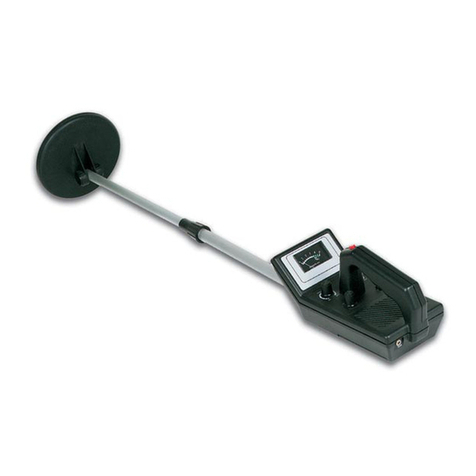
Velleman
Velleman CS100 user manual
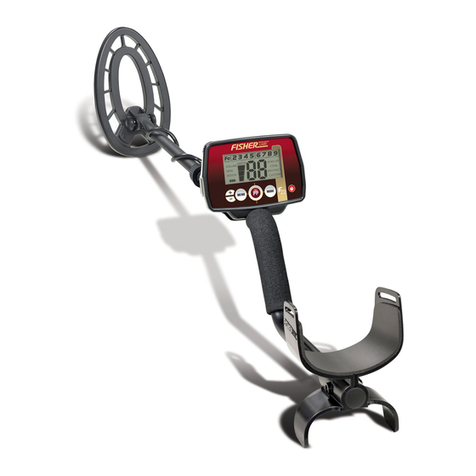
Fisher Research Labs
Fisher Research Labs F22 owner's manual

Minelab
Minelab F1A4 Operator instructions

Gold Rush
Gold Rush Treasure Cove TC-5000 owner's manual

